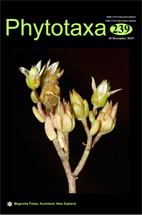Abstract
Phellinus pilatii Černý (1968: 2) was first described from the southern part of Czechoslovakia (now southeastern Czech Republic in the South Moravia region). The species grows on both the living trees and dead wood of Populus alba and P. × canescens, and is characterized by an imperfect stage that produces chlamydospores on scars left by fallen branches on living trees. Basidiomes later develop in the same place as (or on top of) the asexual structures, in tree cavities and on fallen dead trees. The species is distributed throughout south and southeast Europe and warmer parts of Central Europe. The species has been recorded in southeastern Czech Republic, southern Slovakia, Hungary, Italy, Bulgaria, Italy, Romania, countries of the former Yugoslavia and the European part of Turkey (Bernicchia 1995, Denchev and Assyov 2010, Černý 1968, Doğan et al. 2005, Ryvarden and Gilbertson 1994).

